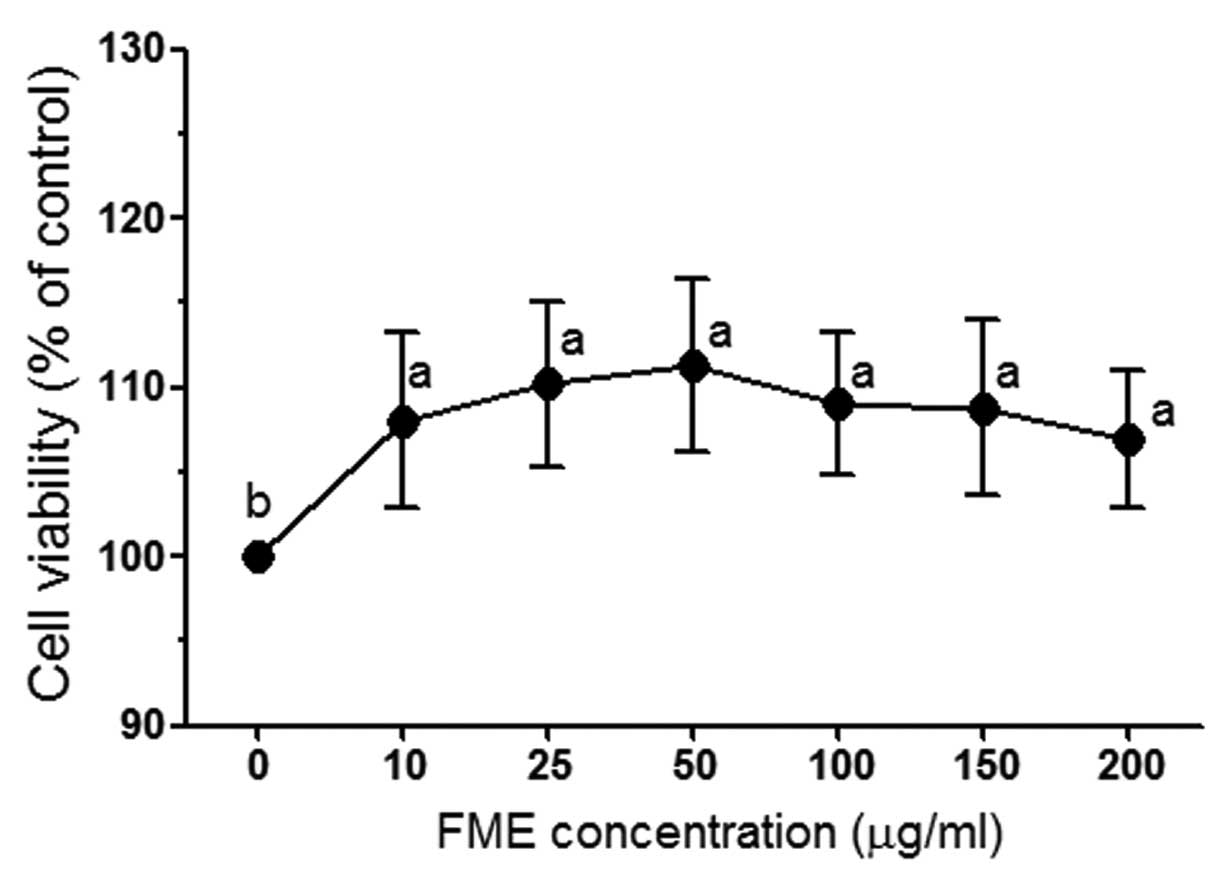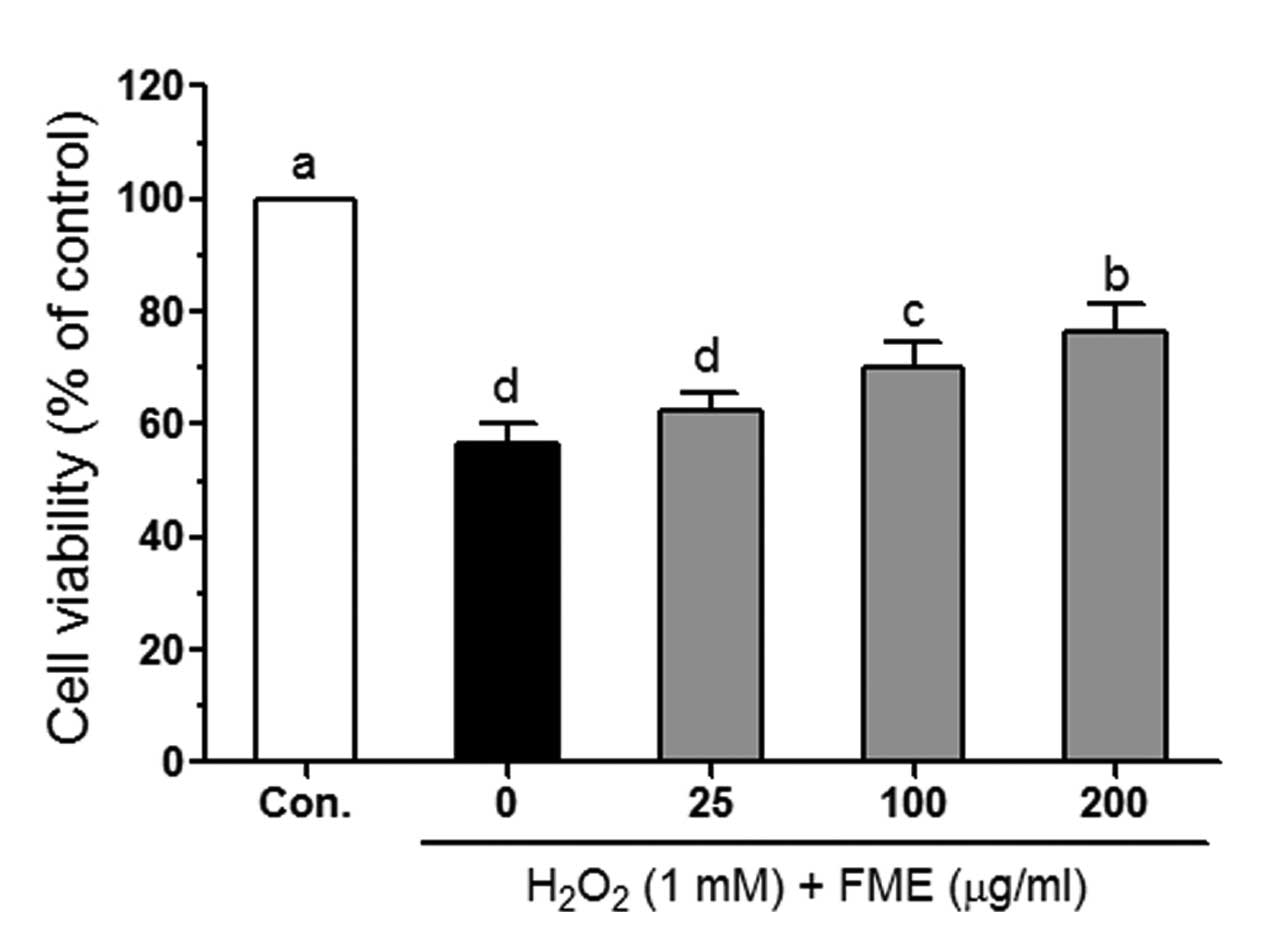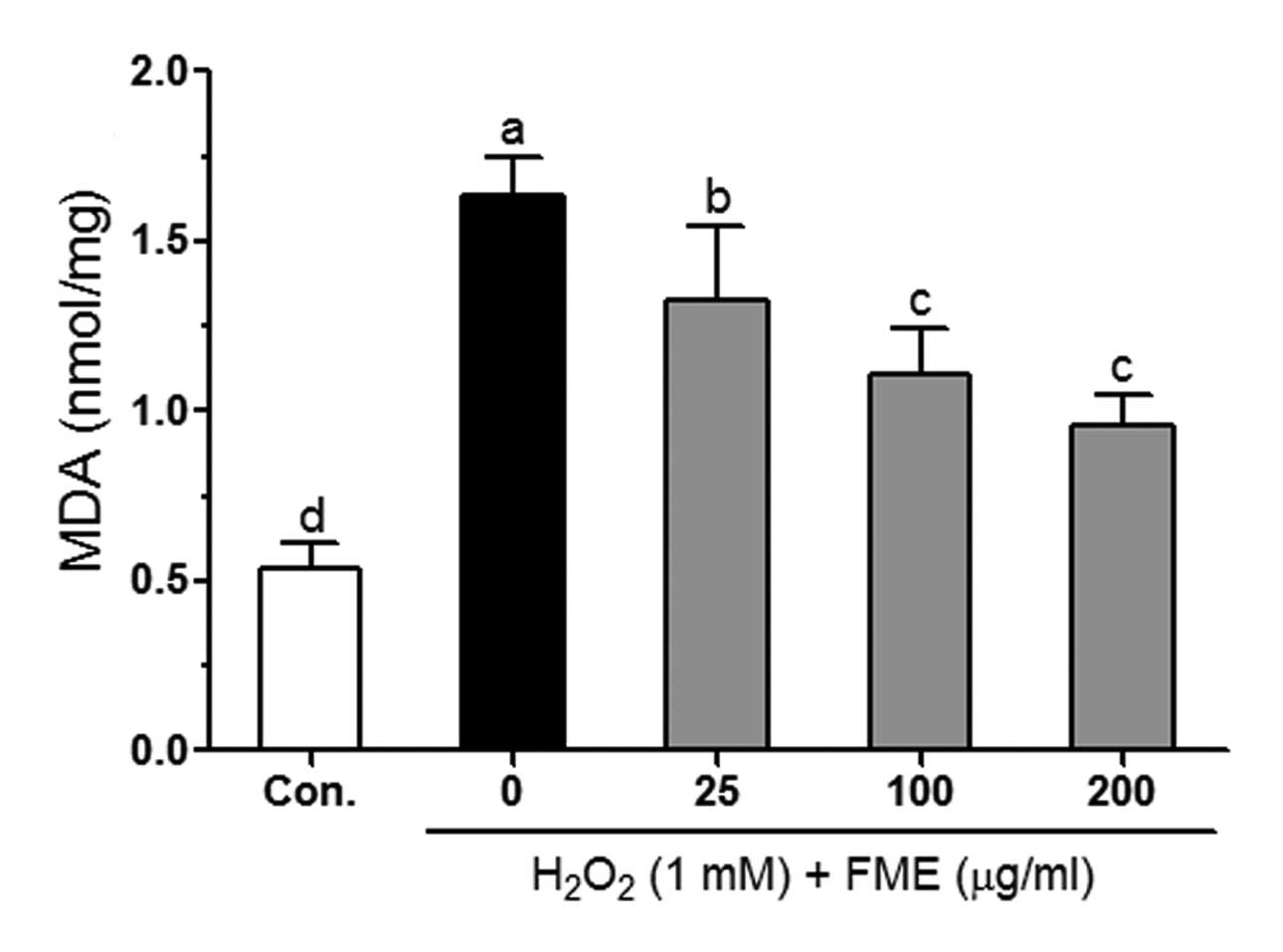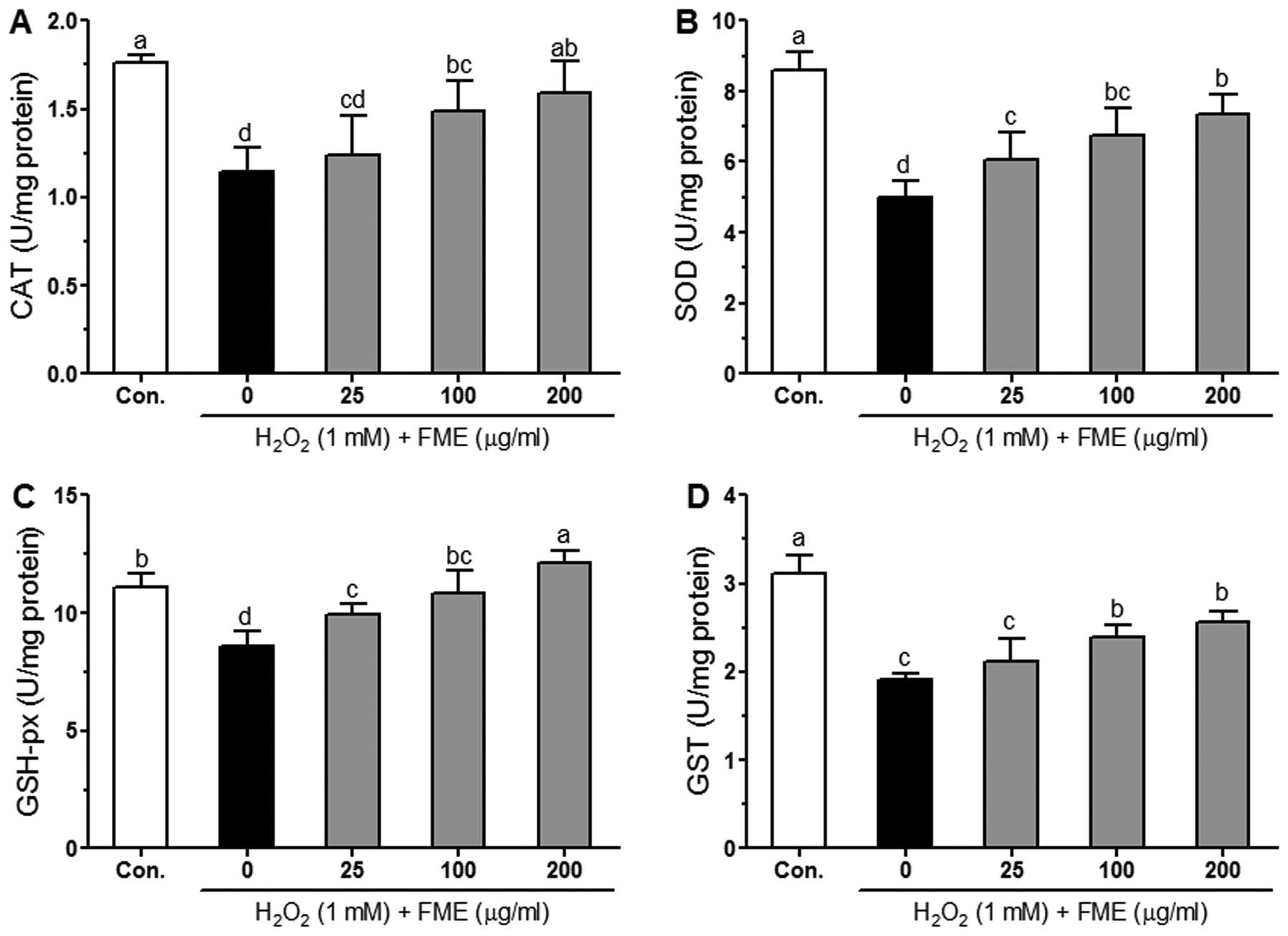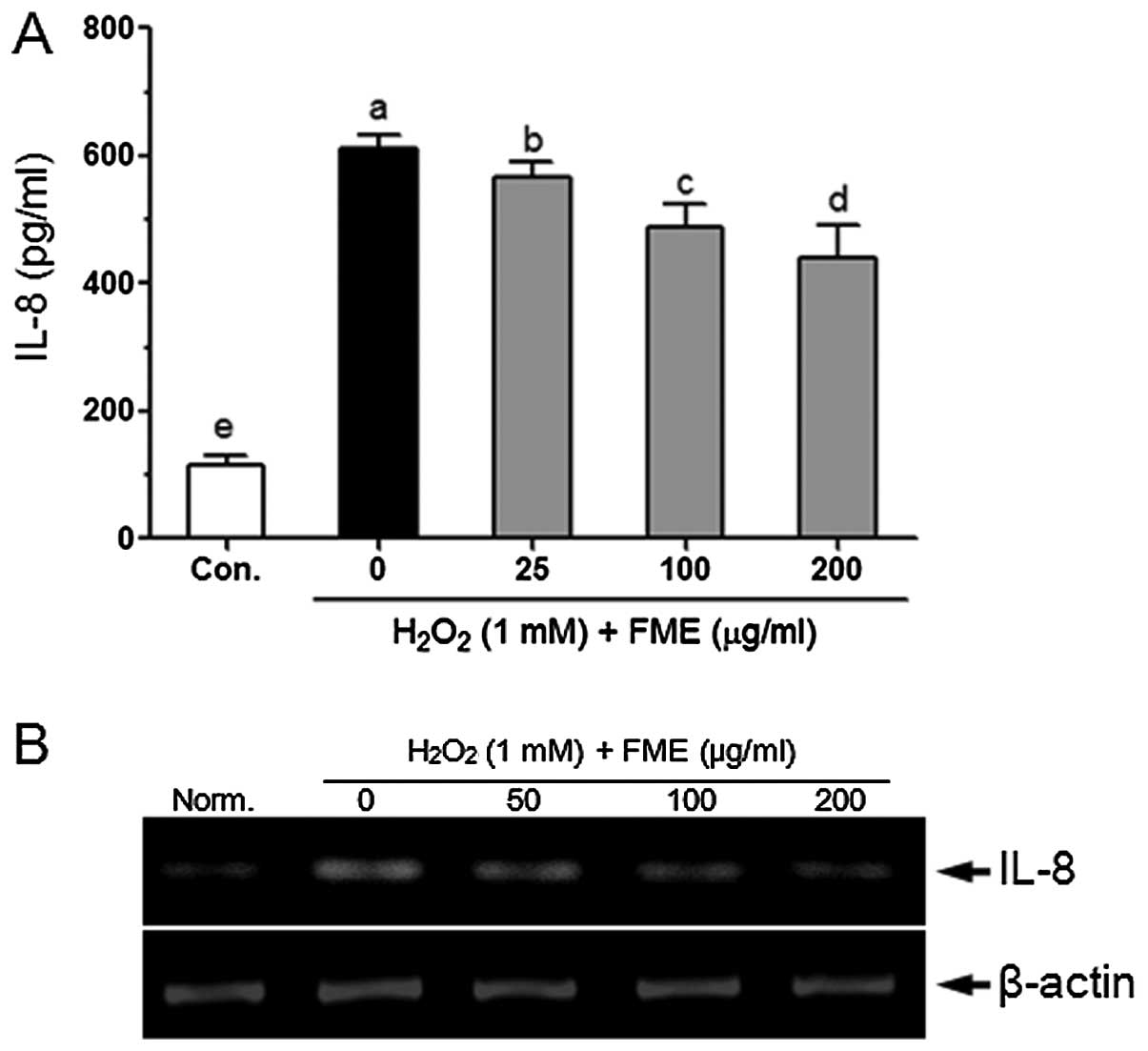|
1
|
Rezaie A, Parker RD and Abdollahi M:
Oxidative stress and pathogenesis of inflammatory bowel disease: an
epiphenomenon or the cause? Dig Dis Sci. 52:2015–2021. 2007.
View Article : Google Scholar : PubMed/NCBI
|
|
2
|
Brieger K, Schiavone S, Miller FJ Jr and
Krause KH: Reactive oxygen species: from health to disease. Swiss
Med Wkly. 142:w136592012.PubMed/NCBI
|
|
3
|
Halliwell B: Reactive species and
antioxidants. Redox biology is a fundamental theme of aerobic life.
Plant Physiol. 141:312–322. 2006. View Article : Google Scholar : PubMed/NCBI
|
|
4
|
Bourlioux P, Koletzko B, Guarner F and
Braesco V: The intestine and its microflora are partners for the
protection of the host: report on the Danone Symposium ‘The
Intelligent Intestine’, held in Paris, June 14, 2002. Am J Clin
Nutr. 78:675–683. 2003.PubMed/NCBI
|
|
5
|
Oz HS, Chen TS, McClain CJ and de Villiers
WJ: Antioxidants as novel therapy in a murine model of colitis. J
Nutr Biochem. 16:297–304. 2005. View Article : Google Scholar : PubMed/NCBI
|
|
6
|
Mazzon E, Muià C, Paola RD, et al: Green
tea polyphenol extract attenuates colon injury induced by
experimental colitis. Free Radic Res. 39:1017–1025. 2005.
View Article : Google Scholar : PubMed/NCBI
|
|
7
|
Song YA, Park YL, Kim KY, et al: Black tea
extract prevents lipopolysaccharide-induced NF-κB signaling and
attenuates dextran sulfate sodium-induced experimental colitis. BMC
Complement Altern Med. 11:912011.PubMed/NCBI
|
|
8
|
Brückner M, Westphal S, Domschke W,
Kucharzik T and Lügering A: Green tea polyphenol
epigallocatechin-3-gallate shows therapeutic antioxidative effects
in a murine model of colitis. J Crohns Colitis. 6:226–235.
2012.PubMed/NCBI
|
|
9
|
Eckmann L, Kagnoff M and Fierer J:
Epithelial cells secrete the chemokine interleukin-8 in response to
bacterial entry. Infect Immun. 61:4569–4574. 1993.PubMed/NCBI
|
|
10
|
Verhasselt V, Goldman M and Willems F:
Oxidative stress up-regulates IL-8 and TNF-alpha synthesis by human
dendritic cells. Eur J Immunol. 28:3886–3890. 1998. View Article : Google Scholar : PubMed/NCBI
|
|
11
|
Yamamoto K, Kushima R, Kisaki O, Fujiyama
Y and Okabe H: Combined effect of hydrogen peroxide induced
oxidative stress and IL-1alpha on IL-8 production in CaCo-2 cells
(a human colon carcinoma cell line) and normal intestinal
epithelial cells. Inflammation. 27:123–128. 2003. View Article : Google Scholar
|
|
12
|
Nielsen O, Rüdiger N, Gaustadnes M and
Horn T: Intestinal interleukin-8 concentration and gene expression
in inflammatory bowel disease. Scand J Gastroenterol. 32:1028–1034.
1997. View Article : Google Scholar : PubMed/NCBI
|
|
13
|
Strober W, Fuss I and Mannon P: The
fundamental basis of inflammatory bowel disease. J Clin Invest.
117:514–521. 2007. View Article : Google Scholar : PubMed/NCBI
|
|
14
|
Ling TJ, Wan XC, Ling WW, et al: New
triterpenoids and other constituents from a special
microbial-fermented tea-Fuzhuan brick tea. J Agric Food Chem.
58:4945–4950. 2010. View Article : Google Scholar : PubMed/NCBI
|
|
15
|
Mo H, Zhu Y and Chen Z: Microbial
fermented tea: a potential source of natural food preservatives.
Trends Food Sci Tech. 19:124–130. 2008.
|
|
16
|
Luo Z-M, Ling TJ, Li LX, et al: A new
norisoprenoid and other compounds from Fuzhuan brick tea.
Molecules. 17:3539–3546. 2012. View Article : Google Scholar : PubMed/NCBI
|
|
17
|
Li Q, Liu Z, Huang J, et al: Anti-obesity
and hypolipidemic effects of Fuzhuan brick tea water extract in
high-fat diet-induced obese rats. J Sci Food Agric. 93:1310–1316.
2013. View Article : Google Scholar : PubMed/NCBI
|
|
18
|
Pinto M, Robine-Leon S, Appay MD, et al:
Enterocyte-like differentiation and polarization of the human colon
carcinoma cell line Caco-2 in culture. Biol Cell. 47:323–330.
1983.
|
|
19
|
Fraga CG, Leibovitz BE and Tappel AL:
Lipid peroxidation measured as thiobarbituric acid-reactive
substances in tissue slices: characterization and comparison with
homogenates and microsomes. Free Radic Biol Med. 4:155–161. 1988.
View Article : Google Scholar : PubMed/NCBI
|
|
20
|
Ellman GL: Tissue sulfhydryl groups. Arch
Biochem Biophys. 82:70–77. 1959. View Article : Google Scholar
|
|
21
|
Nelson D and Kiesow L: Enthalpy of
decomposition of hydrogen peroxide by catalase at 25 degrees C
(with molar extinction coefficients of H2O2
solutions in the UV). Anal Biochem. 49:474–478. 1972. View Article : Google Scholar : PubMed/NCBI
|
|
22
|
Marklund S and Marklund G: Involvement of
the superoxide anion radical in the autoxidation of pyrogallol and
a convenient assay for superoxide dismutase. Eur J Biochem.
47:469–474. 1974. View Article : Google Scholar : PubMed/NCBI
|
|
23
|
Hafeman D, Sunde R and Hoekstra W: Effect
of dietary selenium on erythrocyte and liver glutathione peroxidase
in the rat. J Nutr. 104:580–587. 1974.PubMed/NCBI
|
|
24
|
Habig WH, Pabst MJ and Jakoby WB:
Glutathione S-transferases. The first enzymatic step in mercapturic
acid formation. J Biol Chem. 249:7130–7139. 1974.PubMed/NCBI
|
|
25
|
Bai B, Yamamoto K, Sato H, Sugiura H and
Tanaka T: Combined effect of 25-hydroxycholesterol and IL-1β on
IL-8 production in human colon carcinoma cell line (Caco-2).
Inflammation. 29:141–146. 2005.PubMed/NCBI
|
|
26
|
Gutteridge J: Lipid peroxidation and
antioxidants as biomarkers of tissue damage. Clin Chem.
41:1819–1828. 1995.PubMed/NCBI
|
|
27
|
Masella R, Di Benedetto R, Varì R, Filesi
C and Giovannini C: Novel mechanisms of natural antioxidant
compounds in biological systems: involvement of glutathione and
glutathione-related enzymes. J Nutr Biochem. 16:577–586. 2005.
View Article : Google Scholar : PubMed/NCBI
|
|
28
|
Valko M, Leibfritz D, Moncol J, Cronin MT,
Mazur M and Telser J: Free radicals and antioxidants in normal
physiological functions and human disease. Int J Biochem Cell Biol.
39:44–84. 2007. View Article : Google Scholar : PubMed/NCBI
|
|
29
|
Zhu H and Li YR: Oxidative stress and
redox signaling mechanisms of inflammatory bowel disease: updated
experimental and clinical evidence. Exp Biol Med (Maywood).
237:474–480. 2012. View Article : Google Scholar : PubMed/NCBI
|
|
30
|
Goto Y and Ivanov II: Intestinal
epithelial cells as mediators of the commensal-host immune
crosstalk. Immunol Cell Biol. 91:204–214. 2013. View Article : Google Scholar : PubMed/NCBI
|
|
31
|
Eckburg PB, Bik EM, Bernstein CN, et al:
Diversity of the human intestinal microbial flora. Science.
308:1635–1638. 2005. View Article : Google Scholar : PubMed/NCBI
|
|
32
|
Qin J, Li R, Raes J, et al: A human gut
microbial gene catalogue established by metagenomic sequencing.
Nature. 464:59–65. 2010. View Article : Google Scholar : PubMed/NCBI
|
|
33
|
Macfarlane S, Steed H and Macfarlane GT:
Intestinal bacteria and inflammatory bowel disease. Crit Rev Clin
Lab Sci. 46:25–54. 2009. View Article : Google Scholar : PubMed/NCBI
|
|
34
|
Huycke MM, Abrams V and Moore DR:
Enterococcus faecalis produces extracellular superoxide and
hydrogen peroxide that damages colonic epithelial cell DNA.
Carcinogenesis. 23:529–536. 2002. View Article : Google Scholar
|
|
35
|
Halliwell B: Antioxidants in human health
and disease. Annu Rev Nutr. 16:33–50. 1996. View Article : Google Scholar
|
|
36
|
Wijeratne SS, Cuppett SL and Schlegel V:
Hydrogen peroxide induced oxidative stress damage and antioxidant
enzyme response in Caco-2 human colon cells. J Agric Food Chem.
53:8768–8774. 2005. View Article : Google Scholar : PubMed/NCBI
|
|
37
|
Ji C, Rouzer CA, Marnett LJ and Pietenpol
JA: Induction of cell cycle arrest by the endogenous product of
lipid peroxidation, malondialdehyde. Carcinogenesis. 19:1275–1283.
1998. View Article : Google Scholar : PubMed/NCBI
|
|
38
|
Nair U, Bartsch H and Nair J: Lipid
peroxidation-induced DNA damage in cancer-prone inflammatory
diseases: a review of published adduct types and levels in humans.
Free Radic Biol Med. 43:1109–1120. 2007. View Article : Google Scholar : PubMed/NCBI
|
|
39
|
Manna C, Galletti P, Cucciolla V, Moltedo
O, Leone A and Zappia V: The protective effect of the olive oil
polyphenol (3,4-dihydroxyphenyl)-ethanol counteracts reactive
oxygen metabolite-induced cytotoxicity in Caco-2 cells. J Nutr.
127:286–292. 1997.
|
|
40
|
Aherne S and O’Brien N: Protection by the
flavonoids myricetin, quercetin, and rutin against hydrogen
peroxide-induced DNA damage in Caco-2 and HepG2 cells. Nutr Cancer.
34:160–166. 1999. View Article : Google Scholar : PubMed/NCBI
|
|
41
|
Aherne S and O’Brien N: Lack of Effect of
the flavonoids, myricetin, quercetin, and rutin, on repair of
H2O2-induced DNA single-strand breaks in
Caco-2, HepG2, and V79 Cells. Nutr Cancer. 38:106–115. 2000.
View Article : Google Scholar : PubMed/NCBI
|
|
42
|
Peng IW and Kuo SM: Flavonoid structure
affects the inhibition of lipid peroxidation in Caco-2 intestinal
cells at physiological concentrations. J Nutr. 133:2184–2187.
2003.PubMed/NCBI
|
|
43
|
Intra J and Kuo SM: Physiological levels
of tea catechins increase cellular lipid antioxidant activity of
vitamin C and vitamin E in human intestinal caco-2 cells. Chem Biol
Interact. 169:91–99. 2007. View Article : Google Scholar : PubMed/NCBI
|
|
44
|
Katayama S, Ishikawa S, Fan MZ and Mine Y:
Oligophosphopeptides derived from egg yolk phosvitin up-regulate
gamma-glutamylcysteine synthetase and antioxidant enzymes against
oxidative stress in Caco-2 cells. J Agric Food Chem. 55:2829–2835.
2007. View Article : Google Scholar
|
|
45
|
Aherne SA, Kerry JP and O’Brien NM:
Effects of plant extracts on antioxidant status and oxidant-induced
stress in Caco-2 cells. Br J Nutr. 97:321–328. 2007. View Article : Google Scholar : PubMed/NCBI
|
|
46
|
Kameoka S, Leavitt P, Chang C and Kuo SM:
Expression of antioxidant proteins in human intestinal Caco-2 cells
treated with dietary flavonoids. Cancer Lett. 146:161–167. 1999.
View Article : Google Scholar : PubMed/NCBI
|
|
47
|
Wijeratne SS and Cuppett SL: Potential of
rosemary (Rosemarinus officinalis L.) diterpenes in
preventing lipid hydroperoxide-mediated oxidative stress in Caco-2
cells. J Agric Food Chem. 55:1193–1199. 2007.
|
|
48
|
Aw TY: Determinants of intestinal
detoxication of lipid hydroperoxides. Free Radic Res. 28:637–646.
1998. View Article : Google Scholar : PubMed/NCBI
|
|
49
|
Wingler K, Müller C, Schmehl K, Florian S
and Brigelius-Flohé R: Gastrointestinal glutathione peroxidase
prevents transport of lipid hydroperoxides in CaCo-2 cells.
Gastroenterology. 119:420–430. 2000. View Article : Google Scholar : PubMed/NCBI
|
|
50
|
Carrasco-Pozo C, Gotteland M and Speisky
H: Protection by apple peel polyphenols against indometacin-induced
oxidative stress, mitochondrial damage and cytotoxicity in Caco-2
cells. J Pharm Pharmacol. 62:943–950. 2010.PubMed/NCBI
|
|
51
|
Martín S, González-Burgos E, Carretero ME
and Gómez- Serranillos MP: Neuroprotective properties of Spanish
red wine and its isolated polyphenols on astrocytes. Food
Chemistry. 128:40–48. 2011.PubMed/NCBI
|
|
52
|
Sharma R, Yang Y, Sharma A, Awasthi S and
Awasthi YC: Antioxidant role of glutathione S-transferases:
protection against oxidant toxicity and regulation of
stress-mediated apoptosis. Antioxid Redox Signal. 6:289–300. 2004.
View Article : Google Scholar : PubMed/NCBI
|
|
53
|
Yu MU, Yoo JM, Lee YS, et al: Altered de
novo sphingolipid biosynthesis is involved in the serum
deprivation-induced cell death in LLC-PK1 cells. J Toxicol Environ
Health A. 67:2085–2094. 2004. View Article : Google Scholar : PubMed/NCBI
|
|
54
|
Katayama S and Mine Y: Antioxidative
activity of amino acids on tissue oxidative stress in human
intestinal epithelial cell model. J Agric Food Chem. 55:8458–8464.
2007. View Article : Google Scholar : PubMed/NCBI
|
|
55
|
Ina K, Kusugami K, Yamaguchi T, et al:
Mucosal interleukin-8 is involved in neutrophil migration and
binding to extracellular matrix in inflammatory bowel disease. Am J
Gastroenterol. 92:1342–1346. 1997.PubMed/NCBI
|
|
56
|
Sanchez-Muñoz F, Dominguez-Lopez A and
Yamamoto-Furusho JK: Role of cytokines in inflammatory bowel
disease. World J Gastroenterol. 14:4280–4288. 2008.PubMed/NCBI
|
|
57
|
Zhao Z, Shin HS, Satsu H, Totsuka M and
Shimizu M: 5-caffeoylquinic acid and caffeic acid down-regulate the
oxidative stress- and TNF-alpha-induced secretion of interleukin-8
from Caco-2 cells. J Agric Food Chem. 56:3863–3868. 2008.
View Article : Google Scholar : PubMed/NCBI
|
|
58
|
Satsu H, Hyun JS, Shin HS and Shimizu M:
Suppressive effect of an isoflavone fraction on tumor necrosis
factor-alpha-induced interleukin-8 production in human intestinal
epithelial Caco-2 cells. J Nutr Sci Vitaminol (Tokyo). 55:442–446.
2009. View Article : Google Scholar
|
|
59
|
Netsch M, Gutmann H, Aydogan C and Drewe
J: Green tea extract induces interleukin-8 (IL-8) mRNA and protein
expression but specifically inhibits IL-8 secretion in Caco-2
cells. Planta Med. 72:697–702. 2006. View Article : Google Scholar : PubMed/NCBI
|



